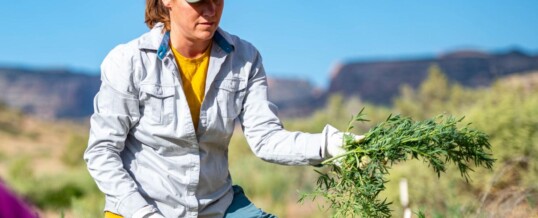
Grand Junction Daily Sentinel, July 17, 2023-
A new seed collection and propagation program along the Monument Connector Trail in Grand Junction is providing more native plants at a lower cost to help restore the ecosystem around the trail.
The program, which started last fall, is a collaborative effort between the Colorado West Land Trust’s Monument Stewards group and the city of Grand Junction.
Volunteers, with direction from the city’s horticulture staff, helped collect seed that is now being grown into seedlings by the city. The plants will be ready to be put into the ground this coming fall, City of Grand Junction Parks and Recreation Parks Supervisor Joe Brown said.
“We started in the fall with our first seed collection,” Brown said. “We then treated the seeds here in house and then we hosted another volunteer group here just recently. Basically what they did was take those treated seeds, planted them up, and then we took another volunteer group who came and helped us transplant it.”
Brown said the city allowed the seeds to freeze over winter, which is necessary for many native plants. It is also giving these seedlings a head start in its greenhouse by providing ideal growing conditions.
“By keeping them cooler in our greenhouse we’re able to extend that growing season,” Brown said. “Theoretically we should be able to get two to three times as much growth as you would normally get outside.”
This controlled process means the plants are better prepared to successfully establish themselves in their native landscape along the trail. This not only lowers the cost, as native plants can be as much as $10 or more to purchase, but increases genetic diversity, he said
“Production of these plants, especially with volunteers involved, costs cents,” Brown said. “Whereas if you were to go and buy them it is quite a bit more expensive and you don’t know what kind of genetic diversity you are getting.”
For Collins and the Monument Stewards, this is a natural extension of the work they’ve been doing for years around the trail corridor, which runs along Monument Road to the Lunch Loops Trailhead. The stewards are a group of volunteers, as well as students from Eureka! Science Museum.
“Volunteers get to engage and learn about our organizations, they learn about conservation and they do real hands-on work,” Collins said. “The idea is also that we’re developing a stewardship corps. We’re developing a group of adult volunteers that have a greater skill set and greater knowledge and these volunteers can be helpful for the next section of the trail.”
That next section of the trail will travel more than a mile and a half west from the Lunch Loops to South Camp Road. Public Works Director Trent Prall said the next phase of the project is awaiting final environmental review and permit approval from federal regulatory agencies, with construction slated to start late fall 2023.
“The city continues to work closely with our partner on the project, the Colorado West Land Trust,” Parks and Recreation Director Ken Sherbenou said in a statement. “The plans are still going through the NEPA (National Environmental Policy Act) process, which the city and the CWLT hope to have complete by this fall. Once through the NEPA process, the city will put the project out to bid, select a contractor and build the trail. In the GOCO grant agreement that is supporting the project, the completion deadline is June 30, 2024.”
This fall the new seedlings will be planted along the already completed trail section, but Brown said the program will continue and could be used to help the area around the next trail section recover following construction.
“Even on a six foot wide trail there’s alway disturbance,” Brown said. “Our native plants, many of these species, can take upwards of 10, 15, 20 years to get to a mature size. So our goal in this is to take those disturbed sites, put in plants that have basically been given a boost, a shot in the arm so they’ll be a few years ahead of what would naturally be growing and help reduce that disturbance so that access is improved for the public without the cost of 10-20 years of ecological growth.”
This year is still considered a pilot project, but Brown said it has been successful enough that it could be used as a model to add more native species to other city managed areas.
“This year was really the pilot. It has been successful,” Brown said. “We actually had a target of a couple hundred plants and I think right now we have 500 or 600. So I’d definitely say we’re successful there … Our real goal for it is to continue to increase diversification so we can use them both in ornamental landscapes, open space and with volunteers.”
By Dan West
Click here to read the full story
ShareJUL
2023
